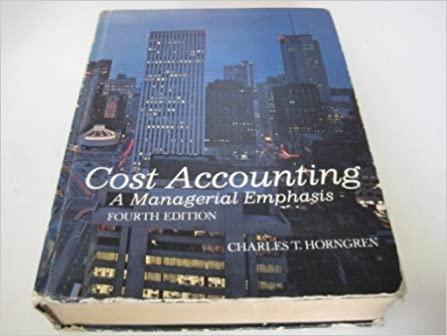Different Cost Terms (CPA) Instructions: You are to match each of the nine numbered items that follow
Question:
Different Cost Terms (CPA) Instructions: You are to match each of the nine numbered “items” that follow with the one term listed immediately below (A through R) that most specifically identifies the cost concept indicated paren- thetically. (Caution: An item of cost may be classified in several ways, depend- ing on the purpose of the classification. For example, the commissions on sales of a proposed new product line might be classified as direct, variable, and mar- gimal, among others. However, if such costs are being considered specifically as to the amount of cash outlay required in making a decision concerning adop- tion of the new line, the commissions are out-of-pocket costs. That would be the most appropriate answer in the context.) The same term may be used more than once.
Indicate your choice of answer for each item by printing beside the item numbers the capital letter that identifies the term you select.
Terms A. By-product cost J. Indirect cost B. Common or joint cost K. Opportunity cost C. Controllable cost L. Original cost D. Direct cost M. Out-of-pocket cost E. Estimated cost N. Prime cost F. Fixed cost O. Replacement cost G. Historical cost P. Standard cost H. Imputed cost Q. Sunk cost I. Differential cost R. Variable cost Items 1. The management of a corporation is considering replacing a machine that is operating satisfactorily with a more efficient new model. Depreciation on the cost of the existing machine is omitted from the data used in judging the proposal, because it has little or no significance with respect to such a decision. (The omitted cost.)
2. One of the problems encountered by a bank in attempting to establish the cost of a commercial-deposit account is the fact that many facilities and services are shared by many revenue-producing activities. (Costs of the shared facilities and services.)
3. A company declined an offer received to rent one of its warehouses and elected to use the warehouse for storage of extra raw materials to insure uninterrupted production. Storage cost has been charged with the monthly amount of the rental offered. (This cost 1s known as? )
4. A manufacturing company excludes all “‘fixed” costs from its valuation of inventories, assigning to inventory only applicable portions of costs that vary with changes in volume of product. (The term employed for the variable costs in this context by advocates of this costing procedure. )
5. The sales department urges an increase in production of a product and, as part of the data presented in support of its proposal, indicates the total additional cost involved for the volume level it proposes. (The increase in total cost.)
6. A CPA takes exception to his client’s inclusion, in the cost of a fixed asset, of an “interest” charge based on the client’s own funds invested in the asset.
The client states that the charge was intended to obtain a cost comparable to what would have been the case if funds had been borrowed to finance the acquisition. (The term that describes such interest charges.)
7. The “direct” production cost of a unit includes those portions of factory overhead, labor, and materials that are obviously traceable directly to the unit. (The term used to specify the last two of the named components.)
8. Calling upon the special facilities of the production, planning, personnel, and other departments, a firm estimated its future unit cost of production and used this cost (analyzed by cost elements) in its accounts. (The term used to specify this screntifically predetermined estimate.)
9. A chemical-manufacturing company produces three products originating in a common initial material mix. Each product gains a separate identity partway through processing and requires additional processing after the “split.” Each contributes a significant share of revenue. The company plans to spread the costs up to the “split” among the three products by the use of relative market values. (The term used to specify the costs accumulated up to the point of the split.) lop5
Step by Step Answer:






